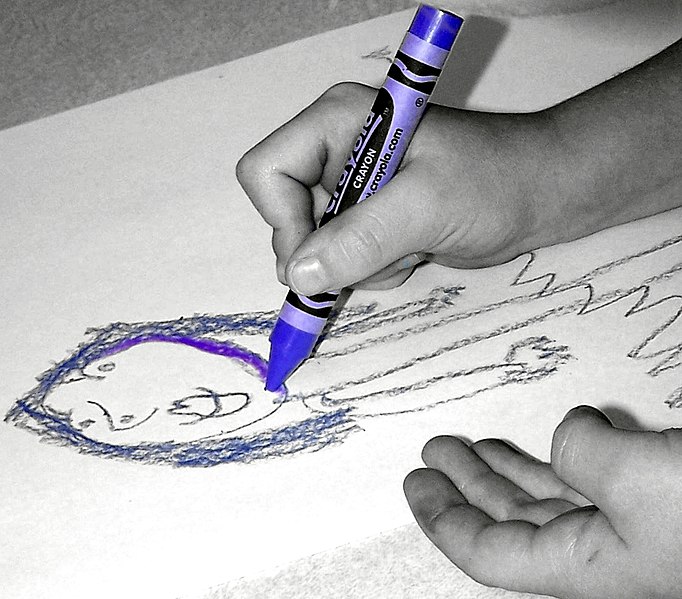 The other day, I posted about the role of art in catechesis. I’ve received a few passionate responses (and I mean that with the most respect) that I want to share with you (I added some links). Thanks for the great conversation!
The other day, I posted about the role of art in catechesis. I’ve received a few passionate responses (and I mean that with the most respect) that I want to share with you (I added some links). Thanks for the great conversation!
Greetings Joe! I disagree that “Catholic Art” has been pushed by the wayside…you just have to look for it and more importantly, when working with children, create an environment that supports their artistic efforts.I have been a certified Catechesis of the Good Shepherd catechist for the past 14 years. The program was founded in Rome more than 50 years ago. A key component to it is “meditative work” which the children do with their hands…very often a “work” following a presentation includes “individual art response”.The atria (classrooms) for ages 3-12 are well-stocked with a variety of tools that the children can select to create their meditative work/response. Supplies include water colors, pencils, colored pencils, crayons, sculpey, etc.In the Level III atria (ages 9-12) we introduce Calligraphy and Illumination as a meditative work. While I don’t harbor any thought that we’re launching the next Donald Jackson* (The Saint John’s Bible — chief calligrapher and illuminator)it is a work that children can select to “slow down” their hands/minds to be one with God.I would encourage your readers to look at the following resources:The Religious Potential of the Child by Dr. Sofia Cavalletti (lots of art responses from children included in this book). Especially helpful is the article on pages 69-72 “The Responsiveness of the Children”…but really the entire book is an extraordinary resource for any catechist working with children…whether you utilize CGS or some other curriculum.The Center for Children and Theology (www.cctheo.org) — the blog often includes the children’s art responses.The Catechesis of the Good Shepherd (www.cgsusa.org)– the annual National Journal always includes art responses submitted by catechists on behalf of the children.There are myriad ways of assisting the child with meditative work well beyond handing them a worksheet. It is up to us as catechists to make this effort, prepare the environment and then get out of the way so that the Holy Spirit can “teach” the child. I also benefitted from having Cy Speltz as a mentor…he is first and foremost an artist who also happened to be a catechist. Hope those resources/ideas help.Best Regards, Karen* He first noticed calligraphy and illumination at age 10______________________________________________________I use art in many of my junior high lessons. In 8th grade after studying the mark of the Church, One, and discussing how our creed is one in belief, I have the students create their own family creed based on character, catholicity, and compassion. This is done on a paper drawn shield on tagboard which must have a design and color to it. They are laminated and some parents have hung them in their homes. We just finished the mark, Catholic, and comparing the Eastern & Western rites of the Catholic Church. 8th graders will read about Eastern crosses, make and color one and write a paragraph why they chose that cross with more than “I liked it.” These will be hung in the JH hallway from the ceiling.. I have done more things in both 7th & 8th incorporating Art since some students are able to express themselves better this way than just the written word.Come to our school and you will see halls filled with Religious Art work from every grade alongside with other subjects.
Anna Marie



I think some of art applications really has to do with both the Director and the catechist. My background includes studies in multiple intelligences and so the shift I’ve made in our programs since taking over is to include learning strategies that incorporate this theory. I also commandeered wall space in our hallway annex between the church and school and this is where our creative masterpieces hang for all to see.
I’m a crafty/artsy/musical kind of a girl – so it comes through in how I teach/organize, etc. I’ve even noticed in some publishers’ manuals, multiple intelligence tie-ins are being made. Art can be a great learning media – and it shows the interpretation of the individual student. How I envision something can be completely different from how my neighbor does – and students begin to see that.
But, then again, I’m a visual/hands-on learner 🙂
Lisa, We all need to teach from our strengths!
Greetings Joe, arts in catechism will enhance the kids in their IQ of understanding better the dogmas of our catholic faith, then creativity and inventions of promoting evrything for the glory of God. Thanks.
Thanks for the great ideas! I am seriously thinking about how we can incorporate more art into our programs.
Dioramas of Lourdes and Cova at Fatima can be constructed inside of a shoe box using salt and flour clay and green foamy strips, silk flowers, leaves, stones, etc., and the figures can be color-copied from Catholic children’s books on the appearances of Our Lady. Many materials can be bought at Joanne Fabrics and/or Michael’s. Also, small figurines of our Blessed Virgin Mary can be used that are three-dimensional. Virtually every significant event in the lives of many saints, including John Bosco, Saint Francis, Saint Therese of Liseaux, etc. These projects would be very inspirational for the child, especially if they could complete them over a series of weeks. Initially, learning in depth the lives and events of each saint before starting a project.
Great ideas, Barabara! Thanks for sharing!